Unsure about your French table manners? Click Here to download > > How to avoid these 10 food etiquette mistakes !
- Home ›
- Destinations ›
- Lyon ›
- One Day in Lyon
The Best Way To Spend One Day In Lyon
Published 4 October 2024 by Leyla Alyanak — Parisian by birth, Lyonnaise by adoption, historian by passion
You’ll be surprised by how much of Lyon you can experience in just one day. While spending several days here would be ideal, even one day in Lyon is enough to capture the city's charm and leave you wanting more. This one-day itinerary covers the must-see highlights, with the best the city has to offer.
A morning in Lyon is a wonderful thing: the cobblestones glow with a light silver hue, and the awakening city has so many sounds − café tables set, market stalls unpacking, and the quiet hum of a boat or two on Lyon's rivers.
Even with only a day, your morning coffee and croissant will fortify you for this extraordinary city − its blend of Roman roots, Renaissance beauty, and a culinary culture that has seduced the world
I've mapped out a one-day Lyon itinerary for you that captures many of the city’s highlights. Still, if you’d like to expand your visit, there are plenty of other things to do in Lyon.
My aim is to get you started, especially if this is your first time in Lyon, and this little Lyon travel guide is your best option for an initiation.
NOTE: Pages on this site may contain affiliate links, which support this site. See full Privacy Policy here.
Lyon is France’s third largest city, or possibly its second largest, depending on the variable you’re using.
Whatever its size, Lyon is the capital of the Auvergne-Rhône-Alpes, one of the largest of France’s 13 mainland regions, as well as the capital of the Rhône, one of the country’s 101 departments. It’s roughly halfway between Paris and Provence, but often gets bypassed by tourists in a hurry to reach the French Riviera.
If they only knew what they were missing!
Welcome, then, to my city.
LYON IN ONE DAY: ITINERARY HIGHLIGHTS
- 8:30 AM: Jardin des Curiosités
- 9:00 AM: Walk to the Basilica of Notre-Dame de Fourvière
- 10:00 AM: Head down into the Basilica's crypt
- 10:30 AM: Visit the Roman ruins and museum
- 11:30 AM: Head down to Vieux Lyon
- 12:30 PM: Lunch in Vieux Lyon
- 2:00 PM: Explore Croix-Rousse and Mur des Canuts
- 4:00 PM: Museum time (either Musée des Beaux-Arts or Musée des Confluences)
- 7:00 PM: Dinner
- 8:30 PM: Stroll through the Presqu'île district
Detailed guide to spending one day in Lyon
And now, a look at your day in Lyon!
Jardin des Curiosités

Begin your morning at the Jardin des Curiosités, a tranquil corner few visitors know about, with panoramic views of the city from above.
The Jardin is twinned with a garden in Montreal to celebrate 20 years of cooperation and exchange between the two cities.
Its site was once part of a military barracks but today, the garden showcases friendship, along with unusual works of art – mostly metal chairs, which allow you to sit and contemplate the cityscape.
SHOULD YOU GET A LYON CITY CARD?
Maybe. Let’s do the math.
A City Card will cost between €26.90-€29, depending on where you buy it. It covers all the museums suggested in the article below, as well as all public transportation inside Lyon (there is an airport version but it costs €49).
Here’s what 1 day in Lyon would cost you if you paid for each item individually (at end 2024):
- All-day transport: €6.70
- Museums: €12-€19, depending on which you choose
- Guided tour by the tourist office: €10
Taking the most expensive options, your day will cost €35.70, whereas with the Lyon City Card, it will cost you €29.
You'll have to pick it up at the tourist office though, so unless you do it the day before, this will take up some of your precious morning sightseeing time.
So yes, it can save you money, but if you're tight on time, you might think twice. As they say, it’s six of one, and half-a-dozen of the other. I usually do get one for the day whenever I'm in Lyon, because I take full advantage of it. If you do the same, you can order it here.
Fourvière Hill and Basilica

You can spot Fourvière Hill and the Basilica of Notre-Dame de Fourvière from Old Lyon below – and from most parts of the lower city, in fact.
The Basilica was built between 1872 and 1884 and stands on the site of an earlier Roman forum.
One of the best things up here is the view, and on a clear day you can see the French Alps in the distance. What do you think? How does this compare with the view from this morning’s Jardin des Curiosités?
There’s something else up here. You’ve probably seen it… it looks disturbingly like a mini-version of the Eiffel Tower!
Fourvière crypt
Below Fourvière Basilica is the Lower Church, often referred to as the crypt, a serene place dedicated to Saint Joseph and filled with intriguing pieces, such as a collection of Virgin Mary statues donated by countries from around the world, with walls covered in frescoes and mosaics.
One of the best sights is the ceiling above the stairway leading down to the crypt…
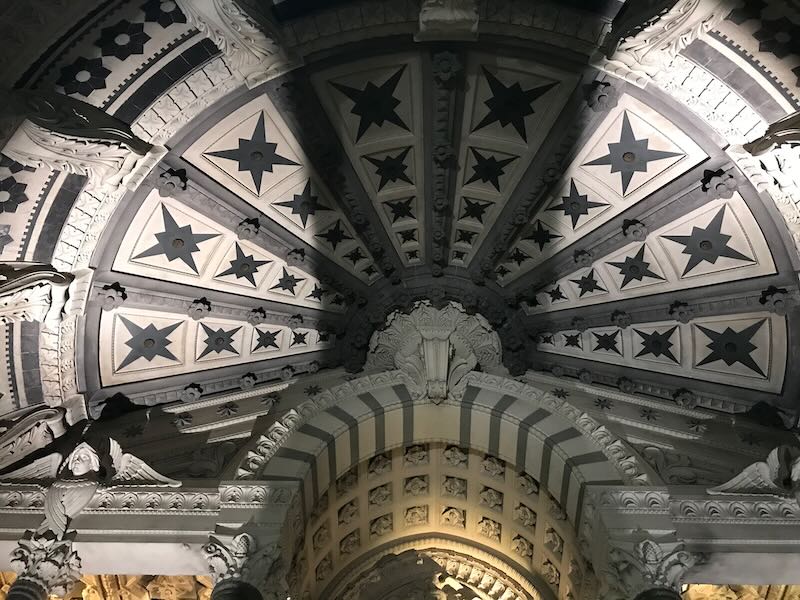
The crypt opens at 10am, which is why I’ve brought you here before heading back to the Roman ruins.
Roman theater of Fourvière
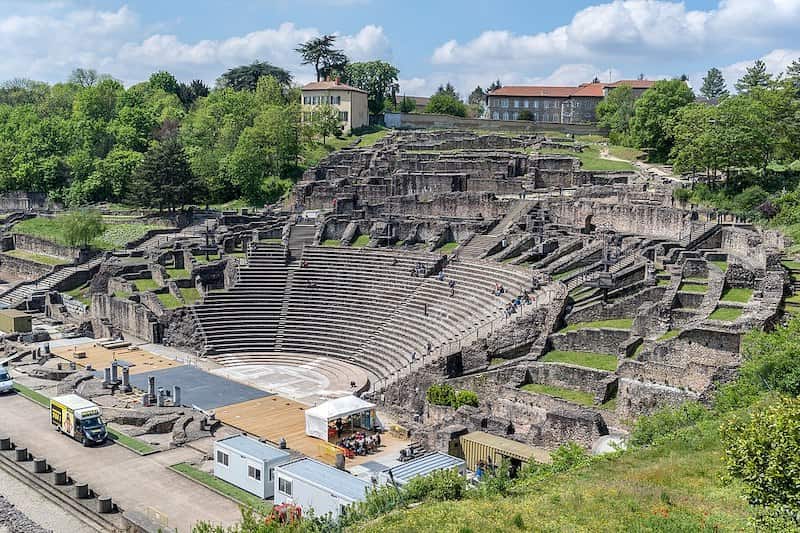
Fourvière Hill is also home to one of Lyon’s most spectacular sights: the ancient theatre of Fourvière, built in 15 BCE by Emperor Hadrian.
The theater once seated more than 10,000 and is still used today for festivals and concerts. Next to it is a smaller Odeon, perhaps even more sophisticated than its bigger sibling.
The theater is part of the larger Lugdunum area, founded in 43 BCE and the capital of the Roman province of Gallia Lugdunensis. Today it is one of the major Roman ruins in France.
A wonderful Gallo-Roman Museum is on the site but since we only have a day and it doesn’t usually open until 11am, we’ll have to either skip it, forgo something else, or switch things around. If you’re a fan of Roman mosaics, statues and everyday objects, then consider including it in your visit.
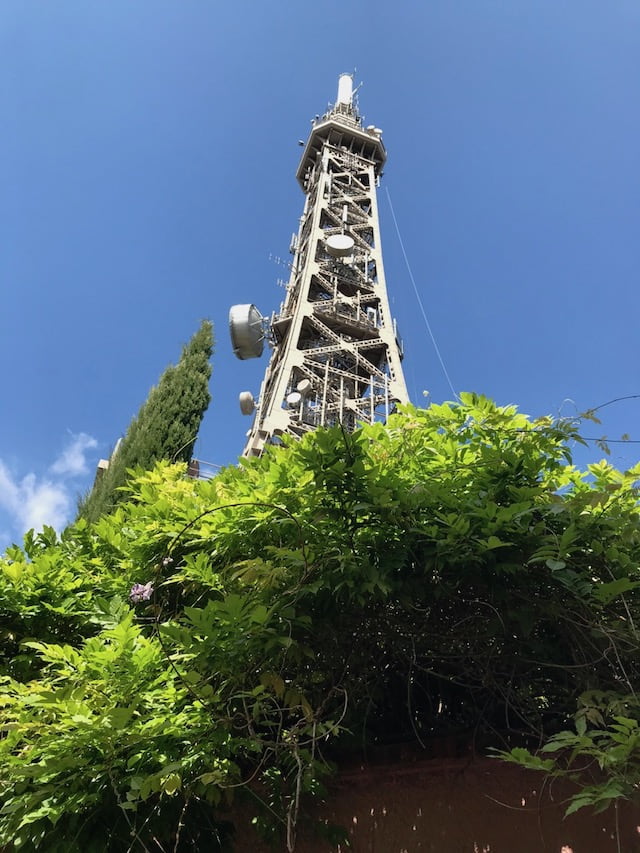 This mini-Eiffel Tower can be seen from most parts of lower Lyon...
This mini-Eiffel Tower can be seen from most parts of lower Lyon...Vieux Lyon and its traboules
Have you heard of traboules? It’s a typically Lyonnais term – a passageway through a building that connects two streets. And Old Lyon is full of them.
This part of town was designated a UNESCO World Heritage site in 1998, and is one of the largest Renaissance architecture districts in Europe. A walk along its 15th- and 16th-century cobblestones will show you why.
You’ll probably start your explorations from the gothic Saint Jean cathedral, whose unique astronomical clock dates back to 1476 (sadly, it's often under repairs because it was vandalized a few years ago).
Afterwards, wander down one of the narrow streets and simply enjoy the small shops and many eateries, which you can sample over lunch.

The Vieux Lyon may be a smallish area but there’s plenty to see, so if your time is limited and schedules match, consider taking a guided tour.
Lunch in Vieux Lyon
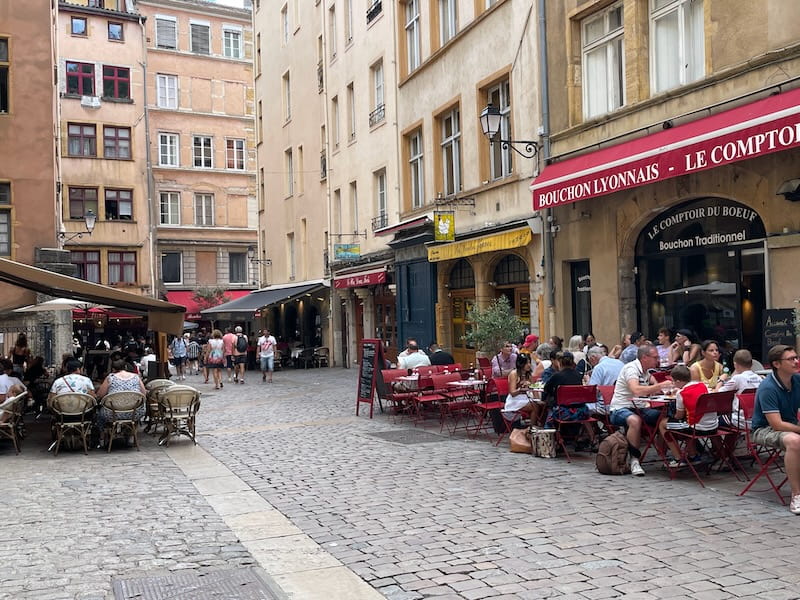
There are plenty of touristy places in Old Lyon, but also many with excellent local specialties – Lyon IS known as the food capital of France, after all.
Some of the best places for typical dishes around Old Lyon include Au Comptoir des Gônes, Aux Trois Maries, L’Auberge des Canuts, and Les Lyonnais Bouchons.
If you’d rather forgo a restaurant meal, a walking food tour is usually a fun experience that allows you to taste a range of specialties while sightseeing.
You don’t HAVE to eat in Old Lyon, though.
If you’re keen to try something different, head for the Halles Paul Bocuse, a luxury covered market whose shops represent the finest products available in Lyon.
Or the rue Mercière, a local concentration of eateries.
Any of these options will be fun.
Mur des Canuts

Have you heard of Lyon's amazing outdoor murals?
One of the best known is the Mur des Canuts, located in the Croix-Rousse district.
Originally created in 1987 by the artist collective CitéCréation, it's about 1,200 square meters in size and shows the daily life of the Croix-Rousse neighborhood, historically known for its silk weavers, or canuts.
It is a cross between trompe l’oeil and naive art, creating a three-dimensional lifelike illusion that makes you want to get up close and examine every detail – and there are many.
Traboules of Croix-Rousse
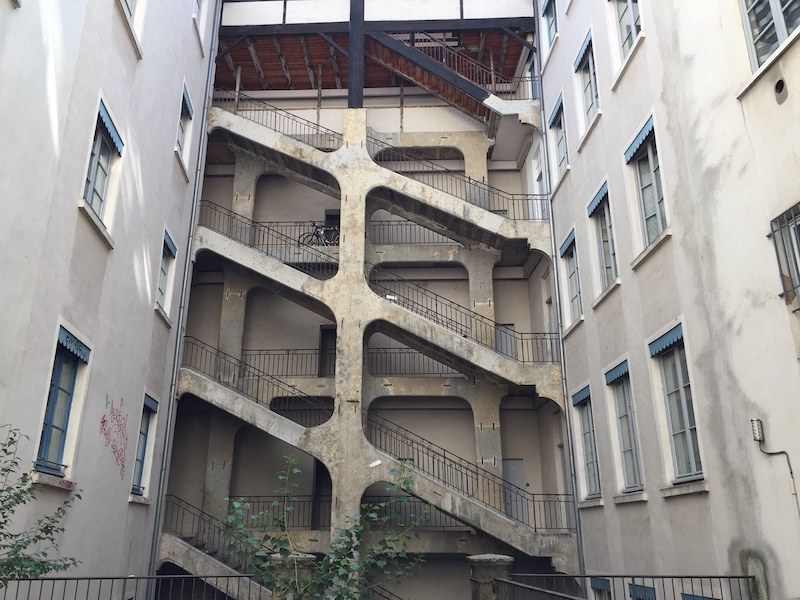
Old Lyon isn’t the only area with traboules: you’ll also find these secret passageways throughout Croix-Rousse, and you can explore these once you’re done with the Mur des Canuts.
Like their Old Town counterparts, most were built centuries ago but were extensively used during the 19th century by silk workers to keep their bolts of silk dry from the rain as they carried them down the hill from their workshops.
Many of these traboules are hidden behind plain doors.
The city has marked some of their entrances with plaques to help visitors find them, and several are open to the public, particularly those along the Rue des Tables Claudiennes and Rue Imbert-Colomès.
Visitors can find the traboules by exploring these streets and looking for the marked entrances, or use this list from the tourist office.
If you’ve had it with traboules and passageways, you could take advantage of being in Croix-Rousse to visit some of the silk-related places in the neighborhood, like the Maison des Canuts, or Silk Museum.
You can also take a guided tour of the Croix-Rousse traboules to learn the history behind them – for example, some were used during World War II to hide members of the Résistance.
Museum time
You won’t be able to see ALL of Lyon’s wonderful museums but you should at least try to visit one of these two.
1. Musée des Beaux-Arts
 ©Laurent Berthier/ONLYLYON Tourisme & Congrès
©Laurent Berthier/ONLYLYON Tourisme & CongrèsIf fine arts fascinate you, this happens to be one of the one of the most important fine arts museums in France outside Paris, with collections ranging from Antiquity to modern art, and such European artists as Rubens, Rembrandt, Delacroix and Rodin.
The building itself is worth seeing: the former Benedictine convent of Saint-Pierre dates back to the 17th century, and its patio garden is an island of tranquility surrounded by an otherwise busy city.
2. Musée des Confluences

If you prefer human sciences to art, head for the Musée des Confluences, located at the confluence of the Rhône and Saône rivers.
The downside is that it is located at the other end of town from Croix-Rousse, with complicated public transport switches.
The museum houses over 2.2 million objects that explore the origins of life, human societies, and the connections between science and art.
The building itself is a major architectural landmark, which the designers describe as featuring “a striking deconstructivist style with glass, concrete, and steel elements”.
The museum’s permanent exhibitions are organized around four major themes: Origins − Stories of the World, Societies − Human Theater, Species − The Fabric of Life, and Eternities − Visions of the Beyond.
Head to the rooftop for some stunning views of Lyon.
Presqu’île district

If you visited the Musée des Beaux-Arts, you’re already in the Presqu'île district. This area was mostly developed during the 18th and 19th centuries, hence the neoclassical style of that era.
This is home to key landmarks such as Place Bellecour and the 19th-century Opéra Nouvel, whose original architecture is now topped by a modern dome.
The Place des Terreaux is home to the famous Bartholdi Fountain, originally created for the city of Bordeaux but rehomed in Lyon after Bordeaux changed its mind (one of many connections between Lyon and Bordeaux).
Another of Bartholdi’s famous creations was the Statue of Liberty…
The district is also known for its evening illuminations, particularly the lighting of the façades along the Saône. Every evening, lights shine on the details of historical buildings like City Hall, the Palais de la Bourse and the Hôtel-Dieu. This should come as no surprise, given Lyon’s broader tradition of urban illumination, seen at its most vivid during the annual Festival of Lights.
The Presqu’île is the perfect place for that leisurely stroll, either before or after dinner.
Dinner in Lyon
Looking for a good dinner that's not too dressy? Take your pick.
Le Bistrot du Potager (Saint-Vincent location) − Located along the Saône River it offers a mix of French and Mediterranean dishes. It has a great riverside view and is known for its welcoming vibe.
Le Bateau Bellona − A casual restaurant and bar on a boat docked on the Rhône River, with panoramic views of the river and city. This is a comfortable spot for solo dining.
La Terrasse Saint-Clair − Although not directly on the Presqu'île, it's a short distance away with a scenic view of the Rhône River. Enjoy French dishes on the terrace.
Want to have a gourmet meal? You’ll be spoiled for choice in Lyon, but my favorite is Têtedoie: it has an amazing view, the owner Christian Têtedoie is a lovely, unpretentious person, and what appears in your plate is a work of art (and yes, sometimes a bit experimental).
If you're watching your budget, consider lunch rather than dinner. Prices are more reasonable, and reservations easier to come by (though some may still need to be booked weeks ahead of time).
Getting around Lyon
Lyon has an efficient public transportation system which makes it easy to explore the main attractions.
Public transportation overview
The TCL network, as it is known, includes four metro lines, five tram lines, 147 bus routes, and two funicular lines that climb to Fourvière Hill and the Gallo-Roman ruins.
A single ticket covers all modes of transport for an hour and can be purchased at vending machines, TCL offices, or through the TCL app (Android only, for now).
Walking is also a great option in Lyon, especially in the city center, and bikes are available for rent at numerous public stands.
If you prefer not to use public transportation, taxis and rideshares like Uber are widely available.
The one transport I won't recommend in Lyon is driving yourself. Traffic can be heavy, roads narrow and crowded, parking limited, and pollution restrictions frequent.
If you'd like more detail, here's an in-depth look at public transportation in Lyon.
How to get to the various attractions
➽ Getting to the Jardin des Curiosités
The best way is by funicular.
- Take the metro from Bellecour station in the city center (Line D, direction Gare de Vaise) for one stop.
- Get off at Vieux Lyon − Cathédrale Saint-Jean.
- Transfer to the funicular (Line F1) to St-Just.
- Leave the station, turn left, and head downhill along the Rue de Trion.
- After a few minutes, turn right on the Pl. de l'Abbé Larue and you’ll see the garden’s entrance gate. This map should help.
Place Bellecour in the city center, by the way, is worth a few minutes of your time: it is one of the largest open squares in Europe.
➽ Getting to Fourvière
Public transport is easiest (but you can also walk up the hill from Vieux Lyon).
- From Vieux Lyon, at the bottom of the hill, take Line F2 towards Fourvière. You’ll see the Basilica as soon as you emerge from the station.
- If you'd like to walk, here’s a map. If you're coming from the Jardin des Curiosités, stop to see the Lugdunum Roman ruins before getting to Fourvière − they're on your way, on the left.
- If you want to take a peek at Lyon’s so-called Eiffel Tower (Tour Métallique de Fourvière) while you're visiting the Basilica, it's only a few minutes' walk.
➽ Getting to Lyon's Roman ruins
They're a five-minute walk downhill from the Basilica (or a little longer uphill from the Jardin des Curiosités).
➽ Getting to Lyon's Old Town
- Take the metro from Bellecour station in the city center (Line D, direction Gare de Vaise) for one stop and get off at Vieux Lyon − Cathédrale Saint-Jean.
- You can walk from Place Bellecour by crossing the Bonaparte bridge over the Saône River. Here's how.
- If you have energy to spare, you can also walk downhill from Fourvière Hill using the Montée Saint-Barthélemy or the Montée du Chemin Neuf, which leads directly to the heart of Vieux Lyon.
➽ Getting to the Mur des Canuts
- The easiest is to take a taxi or rideshare.
- By public transport, there are several options. One alternative is to walk to the Vieux Lyon-Cathédrale Saint-Jean metro station (where the funicular starts from) and take Metro Line D towards Gare de Vaise. Get off at Valmy and take Bus 2 towards Croix-Rousse. Get off at Henon, and walk a few minutes. Here’s the map. As you can see, there are plenty of alternative routes.
- Also, you can walk directly from Old Lyon to the Mur des Canuts. Cross the Saône River and head north through the Pentes de la Croix-Rousse, following signs for the Croix-Rousse district. The walk is about 30-40 minutes, and it takes you through some of Lyon's most historic neighborhoods. Uphill…
➽ Getting to the Musée des Beaux-Arts
- You can walk from Bellecour or Old Lyon. Just head for the Place des Terreaux.
- If you’re on Croix-Rousse hill, you can take public transport by hopping Metro Line C towards Hôtel de Ville-Louis Pradel, which is right next to the Place des Terreaux and the Museum of Fine Arts.
➽ Getting to the Musée des Confluences
- If you're near Part-Dieu train station, take the T1 tram.
- If you're not on the T1 route, use a taxi or rideshare. Otherwise, public transport requires you to transfer at Perrache, the old train station, and that is a mess. If you’ve ever been, you may still be wandering around...
- On the off-chance the boat is running when you want to go, take the Vaporetto from Old Lyon or central Lyon to the Confluence district. Unfortunately, it has restricted hours but it’s an option.
Tours in Lyon
Admittedly, seeing Lyon in 24 hours or less is a challenge. If you’d rather break it up and take a few tours to bunch things together, here are a few I can recommend:
- Lyon food tours are always a good idea, like this one I suggested above, or why not a wine-tasting tour? Lyon is, after all, at the heart of several world-class wine growing regions (Beaujolais, Côtes du Rhône…)
- I also mentioned a tour of the traboules, but there are alternatives which also show you the traboules – just choose the one with the best timing to fit into your day.
 The longest traboule in Lyon
The longest traboule in LyonTravel tips for one day in Lyon
You’ve only got one day in Lyon, let’s make the most of it. Here are a few tips to make your visit even smoother.
- Buy a city map or get a physical one from the tourist office. While I’ve provided a number of links to Google maps, you may want to access directions offline, so I suggest you download Maps.me or download a Google map of Lyon so you can access them easily.
- Lyon is a safe city, at least as safe as any city its size. While your chances of witnessing a crime are low, there are plenty of pickpockets, especially around tourist sites. Make sure you keep your valuables safe by using a money belt or a cross-body anti-theft purse.
- It’s always a good idea to reserve your restaurant (especially if it’s a popular one) ahead of time. Many have online reservations so you won’t have to worry about speaking French on the phone.
- Don’t forget to wear comfortable shoes. You’ll be doing a lot of walking, and there be cobblestones…
- As anywhere in France, it’s always good to be aware of local etiquette, the one and only compulsory issues being “hello” and “goodbye” when you enter and leave a shop (bonjour and au revoir). You can download these basic phrases in French – very few but very useful.
- Many attractions, shops and restaurants in Lyon close for lunch or have specific opening hours, so check these in advance to avoid being disappointed. They also may close one or two days in the week, and not necessarily the days you might expect.
- Be aware of changes in the weather, because it can be unpredictable, even in summer, when hot sunny days can suddenly turn into storms. The shoulder seasons especially are unpredictable, so carry a light jacket or umbrella.
Getting to Lyon
Next to Paris, Lyon is probably the easiest French destination to reach.
It has an international airport, Lyon Saint-Exupéry, with flights to and from 120 destinations – most of Europe, of course, but also North and South America, the Middle East, Southeast Asia, the South Pacific and Australia. Geneva airport isn't far, either.
In other words, getting here is straightforward from anywhere in the world.

There’s a direct tram from the airport to Lyon Part-Dieu, the main train station, making it extra easy to get into town.
You could actually take a day trip to Lyon if that’s all you’ve got – it’s not far from Geneva, and a day trip to Lyon from Paris is possible on the TGV, although I would at least try to spend the night.
If you’re spending the night, here are some hotels near the train station so that you can drop off your bags quickly or catch the train to the airport if you're flying.
Before you go…
Do you have more than one day?
Try one of these day trips from Lyon and get to know the neighborhood.
Although you can see the highlights in one day, please try to stay longer − this is such a delightful city that you'll be doing everything you can to come back!


